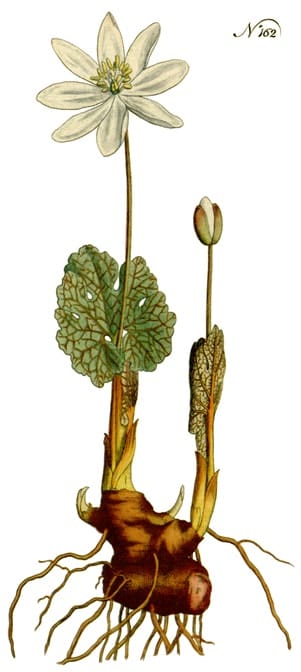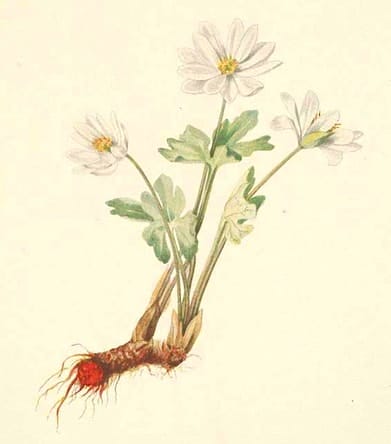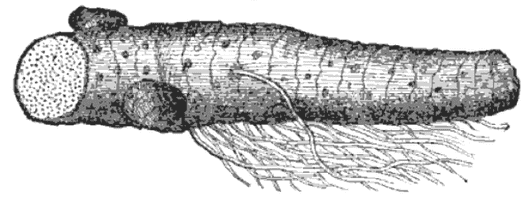Sanguinaria, Bloodroot
Bloodroot, Redroot, Puccoon Sanguinaria canadensis
Sanguinaria canadensis The Botanical Magazine, Curtis, 1792
 Mary Vaux Walcott, North American wild flowers (1925-1927)
Mary Vaux Walcott, North American wild flowers (1925-1927) Bloodroot
BloodrootA Manual of Organic Materia Medica, Maisch, 1882
Botanical name:
Sanguinaria canadensis
Parts used:
Rhizome, root
Temperature & Taste:
Cold, dry. Bitter, Pungent
Uses:
1. Clears Lung Heat:
-Laryngitis Pharyngitis
-Cough, Bronchitis, Whooping Cough, Asthma
-Pneumonia
-Allergic Rhinitis
2. Clears Heat and Damp, Resists Poison:
-Fevers including Intermittent Fever (taken to prevent infection, as well as to treat)
-Chronic Hepatitis
-Gonorrhea, Leprosy, Tuberculosis
-Inflammatory Rheumatism; Acute Rheumatism combined with Gout
-Swellings, Scrofula
-Cancer; specific for Rectal Cancer (Eli Jones)
-Snake Bite
3. Stimulates Digestion:
-Atonic Dyspepsia
-bitter stomachic
4. Moves the Blood, Clears Stasis:
-Amenorrhea, Dysmenorrhea
-Cervical Dysplasia
-small doses (half–1 grain) it slows and strengthens the Pulse (like Digitalis)
5. Benefits the Kidneys:
-regarded as useful for Seminal deficiency, Impotence, Spermatorrhea
6. Externally:
-Gingivitis, mouth and gum sores and ulcers
–Escharotic
-topically to Syphilis, Eczema, Ringworm
-Skin Cancer; ‘Fungous Tumors’
-juice is applied to Warts
-as a snuff to promote sneezing
-Nasal Polyps
Dose:
1. Small doses are expectorant, diaphoretic and stimulant; full doses are purgative and emetic; large doses are toxic.
2. Tincture was considered the best form of internal administration.
3. It was said to lose much of its strength after powdering.
4. A number of modern sources recommend it as being only suitable for topical use.
Powder: 60–500mg (typically 125mg)
Fluid Extract of the Root (1:1): 1/2–5 drops
Dried Root Tincture (1:5 in 60% alcohol): 5–10 drops
Dried Root Tincture (1:10 in 60% alcohol): 10–20 drops
Dry Extract of the Root: 1/8th–1 grain (King’s)
Comment:
Early American herbalists considered Bloodroot one of their most useful plants. A Dr. Tully regarded it as having the effects of Squill, Senega root, Digitalis, Guaiacum, and Ammoniacum without their negative effects. Nevertheless, it was said to be potentially dangerous in unskilled hands.
Substitute:
1. Its effects on the lungs are similar to Lobelia.
2. Bloodroot was often recommended as a substitute for Golden Seal.
3. To clear Damp-Heat and Toxin, Scutellaria Huang Qin or Coptis Huang Lian may be used.
Main Combinations:
1. Hepatitis, Liver heat:
i. Bloodroot with Dandelion, Mint
ii. Bloodroot, Dandelion, Podophyllum
2. Cough, Lung disorders:
i. Bloodroot with Lobelia
ii. Bloodroot with Squill
iii. Whooping Cough, Tincture of Bloodroot, Syrup of Squill
iv. Tincture of Bloodroot, Tincture of Henbane, Syrup of Ipecac
3. Amenorrhea:
i. Bloodroot, Pennyroyal
ii. Tincture of Bloodroot, Tincture of Nux Vomica (2 drams each), Tincture of Aloes (half oz.). Mix, take 20 drops, 2–3 times daily. (Vitalogy, 1906)
4. Cancer, Bloodroot and Thuja can be combined
5. Mouth Cancer, a syrup of Bloodroot, Leptamnium, Orris root, Knotweed (Rafinesque, Medical Flora, 1828)
6. Topically to tumors, with Trillium (Rafinesque, Medical Flora, 1828)
7. Escharotic applied to skin cancer and cancer of the flesh parts such as Breasts Cancers, Bloodroot mixed with Zinc chloride, usually with a little arrowroot or ointment base. Surrounding healthy tissue is protected with plaster, and the paste is applied for 24 hours.
8. Chronic Catarrh, Nasal Polyps, used as a snuff with Bayberry.
9. Mouth and Throat Sores, Bloodroot, St. Johns wort, Orris root (Rafinesque, Medical Flora, 1828)
Major Formulas:
Cautions:
1. Not used during Pregnancy. Regarded as abortifacient.
2. Avoid overdose. Large doses (8–20 grains) cause Nausea and Vomiting, Heartburn, Vertigo, Cardiac irregularity etc. Death has reportedly occurred from overdose.
3. Seeds are narcotic, with effects said to be similar to Datura seed.
Toxicity:
Acute oral LD50 in rats for sanguinarine was calculated to be 1658 mg/kg
Main Preparations used:
Tincture
